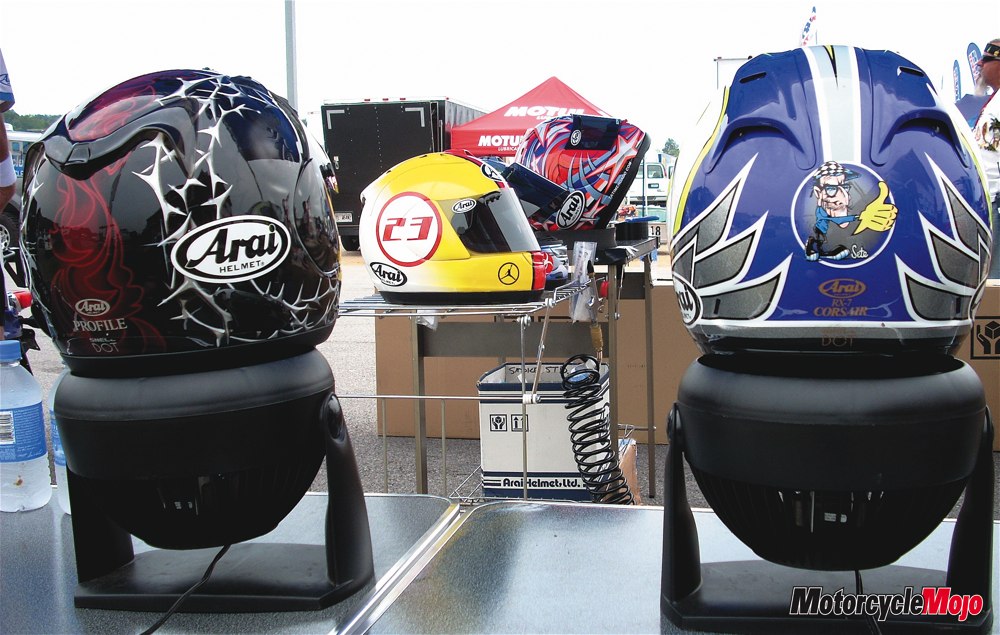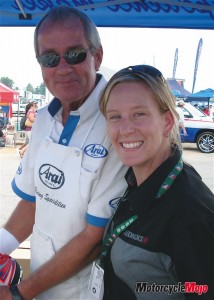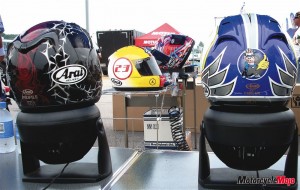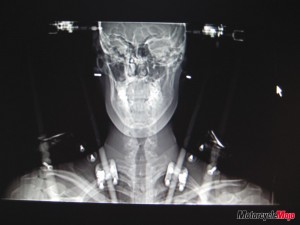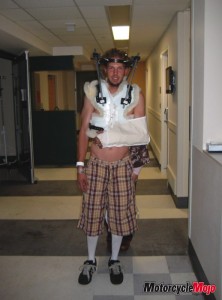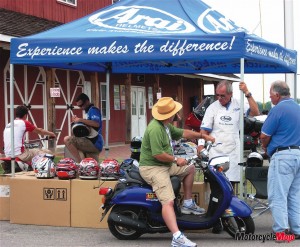There is a man at the AMA races that cares about my head. He cares a lot. Not only does he care about my head and the head of the other racers that he sponsors, he cares about the safety of the heads of riders (and drivers) all over the world and in all disciplines.
That is why he has worked the last 25-years for the world’s oldest helmet company, Arai, and why he continues to go to every single AMA road racing event to provide a hands-on service programme. He is also responsible for Arai’s involvement in Motocross, Snowcross, Dirt Track, all off-road venues, speedway, and shifter karts. It is also why he serves as an advisor for IRL, NASCAR, and Formula One.
His name is Bruce Porter and he says simply, “My work is attached to your pulse,” and I truly believe that his support and his attention to providing proper fitting, superior quality helmets, to myself and my teammate, Josh Galster (along with thousands of other riders) has literally saved our lives.
Bruce is one of my most favourite people in the world and he has said, “In the scope of any human’s life, to be able to say that you had an influence on someone surviving something life-threatening even once, is a wonderful thing. I have had the opportunity to have that happen hundreds of times in my career.”
Most recently, Bruce saved my teammates life. Josh was in a terrible race crash in the beginning of September at Road Atlanta where he high-sided huge, landed on his head and broke his neck. It is my belief that had he not been fitted earlier in the season with a properly sized Arai helmet by Bruce himself, he might have died at the scene or been paralyzed from the neck down.
At the beginning of the season (Josh’s first ever race in the AMA) he was wearing an old, used, worn out and much too big helmet for his head size. Being on a racer’s budget, Josh didn’t deem it necessary to buy a new helmet, and he continued to wear the one he had been using for years, despite the fact that it moved around on his head and sometimes affected his visibility.
It wasn’t until, heading out for one of his races, the strap on his helmet broke and Josh was suddenly without head protection for the imminent race. I grabbed one of my spare XS Arai helmets and said, “You have a small head right Josh? See if this fits.” Josh threw the helmet on and immediately commented on how snug it felt and how much better he could see. It was only then that I realized how poorly the helmet he had been wearing had fit him, and how dangerous that really was to his safety while racing.
Bruce Porter mentions that, “for every ten people that walk up, I’m lucky if one of them owns the correct sized helmet.”
After the race, I took Josh’s broken and well used helmet over to the Arai booth where Bruce diligently works providing race support for his sponsored riders and answering hundreds of questions from the fans that walk up to watch him at work. Bruce had been supporting me as one of his racers for the past year and I asked him, “What is it going to take to get my teammate out of this old broken helmet and into an Arai?”
Bruce took one look at the helmet and said, “All you have to do is ask, Misti. Send him over to me right away.”
Josh had been wearing a size small helmet and by the time Bruce was done with him, he held a brand new XS Arai. It was this new helmet he was wearing when he crashed at Road Atlanta. After the crash, Josh got up and walked back to the pits with an obviously broken wrist and some neck pain. It was only later in the hospital that they found out that he had fractured the C2 vertebrae in his neck. Also known as a hangman’s fracture, this type of break in the neck could have easily resulted in full or partial paralysis. Galster was fitted with a halo, which he has been wearing for the last two months, and will continue to wear for another month, before moving to a hard brace. He is expected to make a full recovery.
After the crash, both Josh and I decided to go to the final round of the AMA at Laguna Seca to watch the races and to pay a special visit to Bruce himself. As Josh walked up in his halo, with his mom and I next to him, Bruce, with tears in his eyes, shook his hand and said, “great to see you Josh.” We all thanked Bruce profusely and made comments on the importance of wearing a good solid helmet, after all, it is your life that the helmet is responsible for.
I got thinking about an article idea and sat down to ask Bruce a few questions.
Q. What are the dangers of wearing a helmet that is too big?
A. An XL Arai tested on a medium headform to SNELL spec, still passes SNELL standards well. This cannot be said of most other helmets. Still, it passes an additional 40Gs of energy through to the headform that would not be passed along with a properly fitting helmet.Q. How do you make sure your helmet fits correctly?
A. Making the helmet to protect you really is rocket science but getting them to fit is very straight forward, and it really comes down to a measurement of the human head, getting the circumference of your head first, so we know we are working from a basic measurement. Our experience with Michael Jordan was that when he came to us he was wearing a double extra large helmet and we put him in a large. No one had ever put a tape measure up against his head.Q. Besides starting with a measure-ment of the circumference of your head, what other things help determine if a helmet fits well?
A. With the helmet on, seeing your eyes right in the middle of the eyeport is important. Eyes high–helmet too big, eyes low–helmet too small. You should not be able to shake your head and have any movement of the helmet.Always remember that it’s a two-step process. Job one–protect the brain–fit the top of your head. Job two–fit your face by adjusting cheek pad thickness. Never buy a helmet to fit your face, there isn’t any brain protection there.
Often when I am working with people trying to establish the right fit and I put them in a helmet that I think we are heading in the right direction with, when I ask them how it fits they will reach up and grab the helmet and say it is too tight. That is one of the reasons that all of our helmets come with removable cheek pads, every shell has seven different possible thicknesses because fitting your face is important but fitting the top of your head where your brain is located is job one. Four different thicknesses of liner per shell size and three different shell sizes, so fitting the main portion of your head where your brain is based on the circumference measurement first and then fitting it with the cheek pads is secondary.
Q. How can the average street rider, just going into a dealership, ensure that he/she is getting a well fitting helmet?
A. Look for someone with a tape measure in their hands.Q. How does Arai differ from other brands?
A. There is only one World’s Oldest Helmet Company, and only one that’s owned by a family that puts its name on every one of its helmets. Today’s modern motorcycle helmet owes 100% of its features to the mind of Arai. The helmet industry looks to Arai to see what’s next. Mr. Arai is very fond of pointing out, about what we do as it relates to professional motorsports, that no one persons head is more valuable than another persons, so we race right from the box, the same product that the top races in the world wear is the same one that the general street rider is going to purchase from a dealership.Q. Why do you do your job?
A. I’m proud to represent the world’s best helmet manufacturer. It’s a privilege to have been given the opportunity to learn so much about such a technical product by the Arai and Weston families. My work is attached to your pulse.Q. Can you wash your helmet?
A. All of the Arai models are fully submersible. The entire helmet is submersible.Q. How long with a helmet last?
A. Short of a crash, it is the contaminants you leave inside the helmet, the acids and oils contained in our perspiration, hair care products, cosmetics, etc, that will affect the life of your helmet. Washing those contaminants from the interior of the helmet is going to extend the life of your helmet. Industry standards say anywhere from 3-5 years but most of the helmets out there are not washable, so trying to wear one past a couple of seasons becomes something of a challenge.Q. Can you wear a helmet again once it has sustained a crash?
A. When it comes to actually crashing a motorcycle with the helmet actually on your head, hitting your head on the ground in a paved environment, almost without exception the helmet is done. It is a single use situation.Q. What if you drop your helmet on the ground or it falls off your bike?
A. A helmet is an action/reaction piece of protection equipment; it’s got a soft EPS (Expanded Poly Styrene) liner inside and a hard outer layer on the outside. If there isn’t five kilograms, roughly 12 lbs of human head inside to react against it, it is just reacting against it’s own 3 lb very resilient make up. So that situation would be OK in the case of an Arai, however, other helmets in the marketplace should still be inspected by a representative of that brand.Q. How does a helmet actually work?
A. It is really made up of two pieces, hard outer shells, designed to do one thing only and that is to take that energy of an impact, and displace it over a broad surface. After it does its job, it passes that energy through the liner and the liner absorbs that energy.Q. Can you say a few things about putting Josh and I in Arai helmets and how you think that helped Josh in his accident?
A. I’m on record as believing that you are one of the most positive people I’ve ever met. Beyond that, with an amazing smile and a wonderful personality, combined with phenomenal racing skills, made you a natural fit to the Arai team. Josh was a natural addition to that effort. Josh’s accident was one of those truly life-threatening incidents. His physical conditioning, his protective package, a chunk of luck, and some help from his guardian angel got him through a tough one.Q. Anything else you want to say?
A. There is no such thing as too much helmet.
Bruce and I continued to talk about the prevalence of riders out there that are wearing old, unsafe and/or ill fitting helmets. I see it all the time working at the Superbike School. At the beginning of the day, I stand at start/finish waiting to introduce myself to my students who are on their bikes and wearing all their gear. While I explain how the day is going to go, they nod their heads in agreement to what I’m saying and in 80% of cases, I see the helmet bobbing back and forth on their heads. I always say, “Your helmet is too big for you, you should really try a smaller one on.” Some do and are usually surprised by how much more visibility they have and how much more comfortable they are. Some continue to believe that the size they are wearing is correct.
Aric Eisenberg, a Superbike School student from October 2008 said, “Misti from the Superbike School advised me that I should wear a smaller helmet because it looked to her like my Medium Shoei was too big. I tried on a smaller helmet and it was 100% better. It made the biggest difference and I am so happy she told me about that. I did not even know that my helmet was too big, I thought it was perfect but I guess I was wrong.”
And finally, famous late night talk show host and motorcycle enthusiast, Jay Leno, after doing an interview with Bruce Porter on his show commented, “I realized that for the last 2 years I’ve been wearing the wrong size helmet. I always had a helmet that was a little large for me and it would move around a little on my head and I always thought that was kinda what it was supposed to do, then I met this guy at Laguna Secca, Bruce Porter from Arai and he has set me straight. I went from a Large to a Medium. What a difference a proper fitting helmet makes when riding. Bruce you are a lifesaver. Thank you very much.”
Bruce Porter and the Arai helmets he fits specifically to the size of your head are indeed lifesavers. He moved me from a size XS to a XXS, and I’ve unfortunately had the chance to test several of them over numerous race crashes. I’ve never had a concussion or any kind of head trauma and never once have I questioned the importance, or the cost, of wearing a high quality helmet. They are designed to save your life, so do your part, and make sure the helmet you wear is in good shape, is not too old, and it fits the circumference of your head, where your brain is! MMM
Ride Safe, Misti
Misti Hurst is a motorcycle racer, an instructor and a freelance writer. Visit her website www.mistihurst.com.









